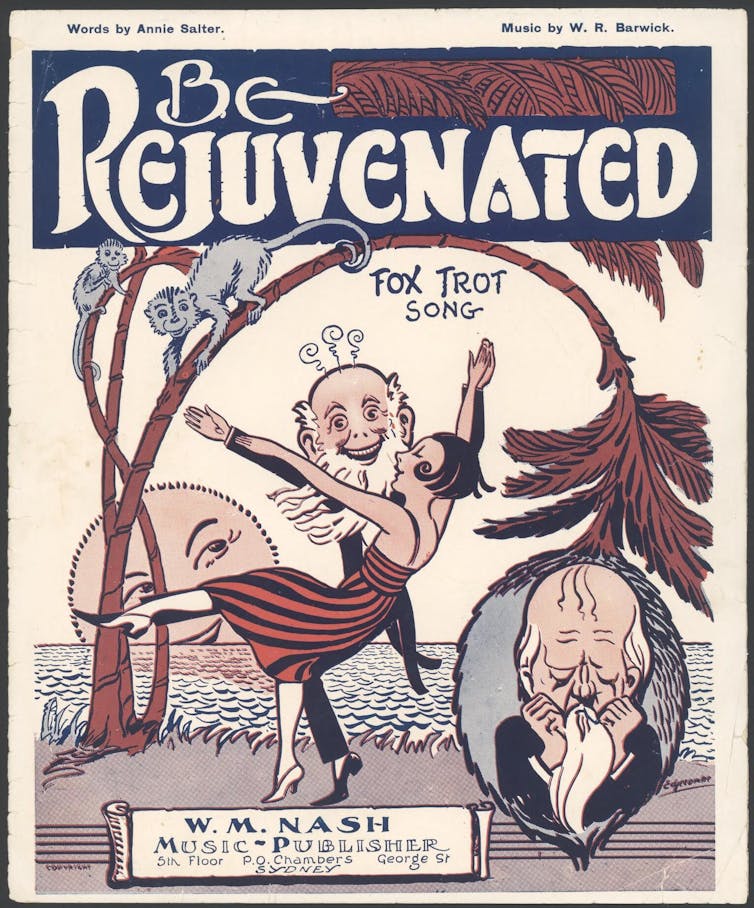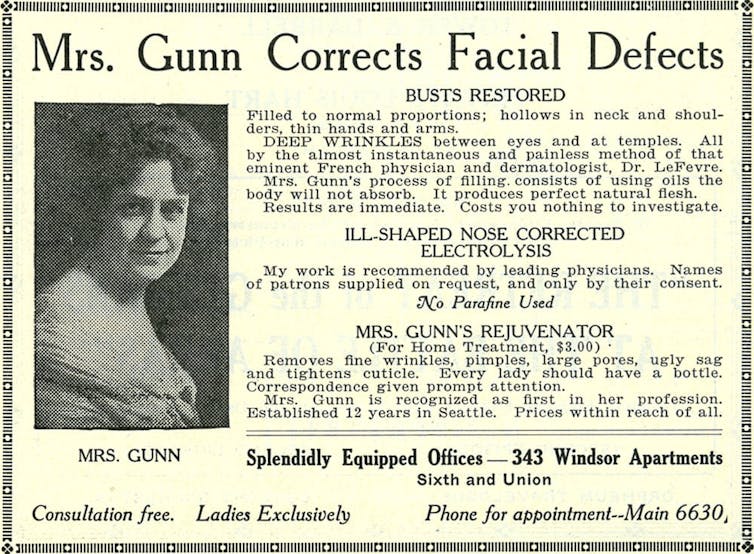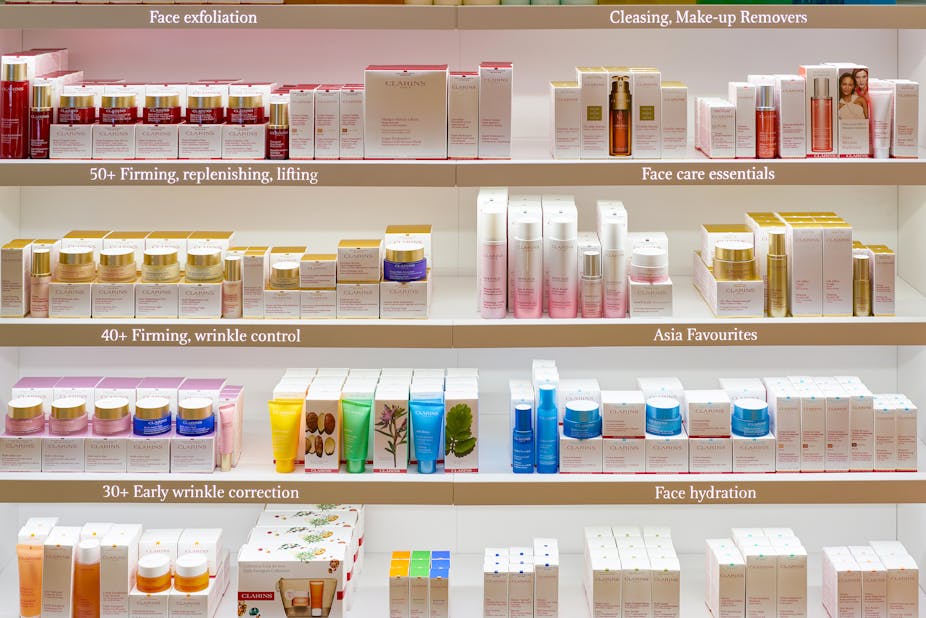Our obsession with looking and feeling younger isn’t unique to the 21st century. In fact, we’ve been searching for ways to turn back the clock for centuries.
Cleopatra reportedly bathed in milk to preserve her youth, women in the Elizabethan era wore thin slices of meat on their faces to get rid of wrinkles, and Spanish explorer Juan Ponce de Léon was rumoured to have been searching for the mythical fountain of youth when he discovered Florida.
Although humans had long been trying to cheat ageing, the period immediately after the First World War saw new strategies to rejuvenate the body and mind gain popularity, as I write in my recent book. These included everything from surgical procedures that aimed to manipulate sex hormones, to everyday beauty products, like skin “foods” and moisturising creams.
All of these methods promised wildly different results. In the case of male hormone treatments, a patient might expect to regain lost fertility as well as energy. Everyday cosmetic products, marketed almost exclusively to women, promised a restored youthful appearance.
Different types of rejuvenation were considered appropriate for men and women. In men, renewed sexual function and economic productivity was the goal. For women, a return to youthful beauty was deemed to be of greatest value. Prolonging life was a goal for eugenicists and medicine, but it was not a universal concern for would-be rejuvenators. Most instead concentrated on extending their youth.

Electrical “therapies”, which anyone could use in their home, were also popular. One of the most widely used electrotherapy devices during the late 1920s through to the 1940s was the Overbeck Rejuvenator, which was claimed to be able to restore lost vitality by restocking the body’s supply of electrical energy. Depending on which ailment the user wanted to treat, electrodes were applied to the body on a daily basis, and a small electric current was administered.
The inventor of the Rejuvenator was Otto Overbeck, an enterprising chemist who worked in the brewing industry. He wrote two books on the subject, the first of which was published in 1925, and used these to claim that his machine would have positive results in all conditions – apart from infectious diseases and “deformities”.
Despite a study concluding that the device’s current was not strong enough to have any effect, electrotherapy continued to be popular.
In 1912, Austrian physiologist Eugen Steinach devised a series of experiments designed to manipulate the levels of “sex hormone” (testosterone) in guinea pigs. He concluded that the secretions of the testes governed sexuality and sexual activity and behaviour.
Based on these findings, Steinach then began performing partial vasectomies on men in an effort to increase the production of testosterone and “rejuvenate” his patients. But an article published in 1923 was sceptical about his work, which had “an apparently irresistible appeal to elderly persons whose waning virility renders them disconsolate and fretful.”
Steinach generated great public interest in his work and inspired a loyal group of supporters within the medical profession. He was nominated for the Nobel Prize in Physiology on several separate occasions between 1921 and 1938 for his pioneering work in the fields of endocrinology, urology, and sexual health. He was also a key figure in the development of endocrinology. But he was also subject to fierce accusations of quackery and deception.
“Rejuvenations”
Public audiences were fascinated by press reports of successful rejuvenations using his procedure. The so-called Steinach operation was a fairly expensive treatment, and it became fashionable among the higher levels of society, as well as many artists. These included the Irish poet W. B. Yeats, who claimed that the procedure inspired him to new artistic heights.

For those unable to afford a personal treatment by Steinach, a huge range of rejuvenating options gradually became available. New diets, exercise regimes, and cosmetic products found receptive audiences who were anxious about ageing. Many of these were advertised as essential parts of a healthy life, which also promoted youthfulness.
For example, in his 1923 book Rejuvenation, the French self-styled anti-ageing specialist Jean Frumusan identified a series of domestic habits designed for staying healthier for longer.
These included instructions like drinking a large glass of water after waking up, and jumping out of bed immediately. Frumusman also advised people to “eat slowly and moderately” and to be “carnivorous at one meal, vegetarian at the next.” Frumusan also advocated periodic fasting for 24 or 48 hours at a time to restore the vitality of the body.
Read more: Fitness gurus and 'muscular Christianity': how Victorian Britain anticipated today's keep fit craze
Anti-ageing cosmetic products were also popular, marketed primarily to women. Cosmetic magnates like Helena Rubinstein and Elizabeth Arden sold youthfulness to women of all ages. They and their contemporaries created a mass market for new anti-ageing products and services that has become embedded within 21st-century culture.
Rubinstein launched her “Hormone Twin Youthifiers” in the United States in 1931. These were two creams - day and night - which included oestrogen to replace “the vital glandular secretions of youth”.
Arden shunned the use of hormones in her products but did introduce her famed “Vienna Youth Mask” in 1927. This device used diathery (small electrical currents) to warm a person’s facial tissues and with the goal of preserving preserve a youthful complexion.
Popular rejuvenation methods in the early 20th century were remarkably different from one another – showing the rich range of ideas and theories about ageing. Rejuvenation was one of the most prominent and fascinating topics of public interest in the 1920s and 1930s, and gave rise to society’s enduring obsession with looking and feeling young.

